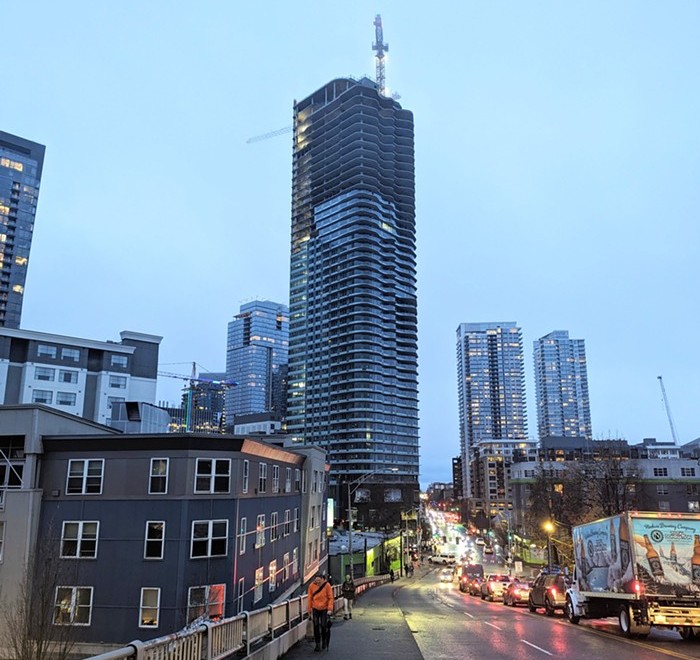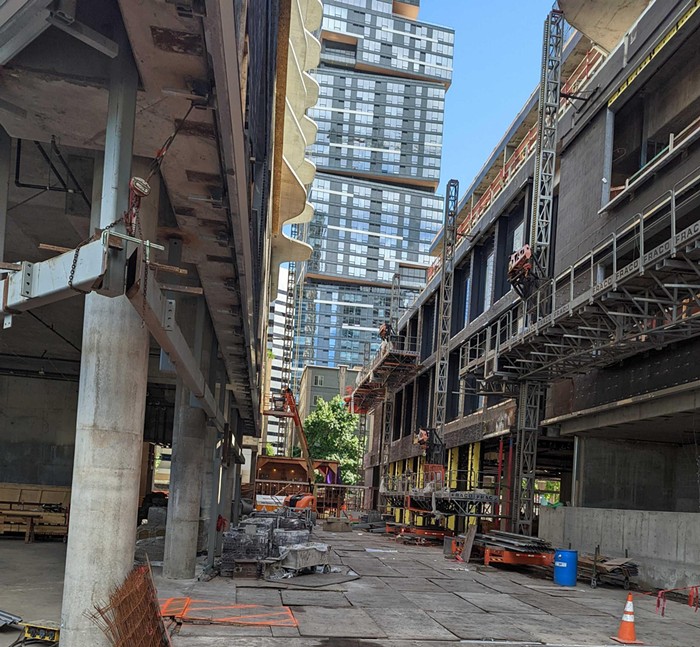
Despite all of the new buildings rising from all parts of Seattle's business district, rising from a building boom that's now in its seventh year and still has yet to have an end in sight, only one has dramatically changed Seattle's skyline, the Rainier Square Tower. It can be said that the narrative of the skyline was pretty much the same until the top floors of the NBBJ-designed Rainier Square Tower reached the region of completion six months ago. It now stands as the second-highest tower in Seattle. The highest is, of course, the Columbia Center, and the narrative of the skyline it established on the side of our downtown that faces west (the prime skyline) was an upward climb, from north to south, to its peak. At that point, the skyline abruptly dropped down to the Smith Tower, a skyscraper constructed during the early years of the previous century.
The Space Needle never played much of a part in this narrative. It has and will continue to stand alone and to transmit only its own story, which is that of a relic from an age that the primary Cold War belligerents promised, the Space Age, but failed to realize. The Space Needle is now in the same cultural archaeological site as the dead astronauts in that J.G. Ballard short story. The Rainier Square Tower, however, brought an end to the old narrative of the skyline. It has made it tell a new story.
Seattle skyline 😍😍😍 pic.twitter.com/9lUPOrA8o8
— Deeptanshu Malik (@deeptanshuMalik) February 16, 2020
What is the new narrative introduced by Rainier Square Tower, which rose from the ground not without controversy—it is the building Amazon used to make its authority in town known, when the Seattle City Council decided to tax local corporations? Amazon wanted nothing to do with this "head tax," and did not care where the money was going and trying to do—in this case, alleviate some of the homeless crisis caused by real estate speculation that was excited by Amazon's success. The e-commerce behemoth stopped construction of the Rainier Square Tower until the city council came to its senses. And it did. The tax was killed. Building resumed. And in the near future, the top floors (41 through 58) of the 850-foot building will be sold as luxury apartments. These will be the highest apartments in Seattle.
But the skyline now has a new narrative. It is this: The Rainier Square Tower has brought an end to one story. The story that has a clear beginning (the low buildings in the south) and end (the cluster of towers on 5th and Columbia), and introduced self-reflexivity (dub) to the skyline. How so?
Now, recall that lovely Sundays tune, "Here's Where the Story Ends."
Columbia Center can no longer sing this song (or tell this kind of story). Rainier Square Tower brought an end to the end of the skyline. One tower (Rainier) has turned an older tower (Columbia) away from its outward orientation and its punctual function as Seattle's full-stop. The Columbia Tower now faces inward and has its end where Rainier Square Tower begins, and the Rainier Square Tower ends where the Columbia Center begins. And all that can break them out of this loop is the introduction of a pronounced tower either north of Rainier Square Tower or south of Columbia Center. If it's the latter, then the skyline will tell the story of the Chinese character for mountain. In short, it will be the dub of Mount Rainier.
Hey, Ningxia fans! It’s time to learn Chinese!
Helan Mountain is one of the great places in Ningxia for mountain climbing in spring.
Do you know what the Chinese character in the following picture stands for? Comment below to let us know!#DiscoverNingxia #Spring #HelanMountain pic.twitter.com/XDDPx6N3Db
— Discover Ningxia (@DiscoverNingxia) May 4, 2019















